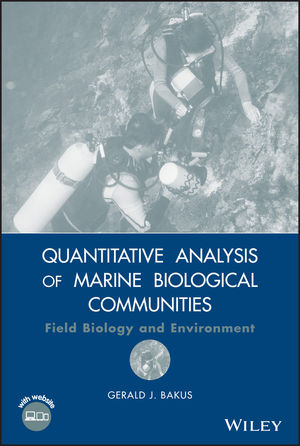Quantitative Analysis of Marine Biological Communities: Field Biology and EnvironmentISBN: 978-0-470-04440-7
Hardcover
456 pages
January 2007
 This is a Print-on-Demand title. It will be printed specifically to fill your order. Please allow an additional 10-15 days delivery time. The book is not returnable.
|
||||||
Preface xi
Acknowledgments xiii
Contributors xv
1. Biological Sampling Design and Related Topics 1
1.1 Profiling Methods and Underwater Techniques 1
1.1.1 Introduction 1
1.1.2 Profiling a Beach 1
1.1.3 Underwater Profiles 2
1.1.4 Underwater Techniques 3
1.2 Sampling Populations 5
1.2.1 Introduction 5
1.2.2 Sampling Design 8
1.2.3 Physical-Chemical Factors 9
1.2.4 Timing of Sampling 9
1.2.5 Size of the Sampling Area 9
1.2.6 Scale 9
1.2.7 Modus Operandi 10
1.2.8 Sample Size or Number of Sample Units Required 10
1.3 Quantitative Sampling Methods 14
1.3.1 Introduction 14
1.3.2 Table of Random Numbers 15
1.3.3 Quadrat Shape 16
1.3.4 Optimal Quadrat Size 17
1.3.5 Simple Random Sampling 19
1.3.6 Haphazard (Convenience, Accidental, Arbitrary) Sampling 19
1.3.7 Stratified Random Sampling 20
1.3.8 Systematic Sampling 21
1.3.9 Fixed Quadrats 23
1.3.10 Point Contact (Percentage Cover) 23
1.3.11 Line and Belt (Strip) Transects 24
1.3.12 Adaptive Sampling 25
1.3.13 Sequential Sampling 26
1.3.14 Rapid Sampling Methods 27
1.3.15 Introduction to Plotless Sampling 28
1.3.16 Best Guess or Estimation 28
1.3.17 Catch or Weight Per Unit Effort (CPUE) 28
1.3.18 Coordinate Lines 29
1.3.19 Cluster Sampling 29
1.3.20 Introduction to Distance Measurements 30
1.3.21 Nearest Neighbor and Point to Nearest Object 31
1.3.22 Point-Center Quarter or Point Quarter Method 33
1.3.23 Line Intercepts 36
1.3.24 Strong Method 38
1.3.25 Weinberg Method 39
1.3.26 Nishiyama Method 42
1.3.27 Mark (or Tag) and Recapture (Mark and Resight) Techniques 44
1.3.28 Visual Methods for Fishes 51
1.3.29 Narcotizing Agents and Poison Stations 52
1.4 Other Methods of Estimating the Abundance of Populations 52
1.4.1 Comparison of Estimated Populations with Other Methods 52
1.4.2 Removal Trapping or Collecting 52
1.4.3 Other Methods 53
1.4.4 Large Scale Sampling 56
2. Types of Data, Standardizations and Transformations, Introduction to Biometrics, Experimental Design 62
2.1 Introduction 62
2.2 Types of Data 63
2.3 Data Standardization or Normalization (Relativization) 64
2.4 Data Transformation 66
2.5 Statistical Distributions and Procedures 68
2.6 Descriptive Statistics (Sample Statistics) 75
2.7 Statistics with One or Two Variables 81
2.8 Experimental Design and Analysis 96
2.9 Power Analysis 100
2.10 Multiple Comparisons Tests 100
2.11 Nonparametric Tests, Covariance, Correlation, and Regression 102
2.12 Multivariate Statistics 109
2.13 Ranking Analysis (Nonparametric Correlation) 109
2.14 Randomization Methods 112
2.15 General Linear Programming 114
2.16 Maximum Likelihood 118
2.17 Bayesian Statistics 119
2.18 How to Lie with Statistics 122
3. Quantitative Methods in Field Ecology and Other Useful Techniques and Information 123
A. Introduction 123
3.1 Introduction 123
B. Population Patterns 123
3.2 Distributions (Dispersion) 123
3.3 Dispersal 127
3.4 Home Range 128
3.5 Random Walk 129
3.6 Feeding Ecology 131
C. Population Growth 132
3.7 Size-frequency Distribution 132
3.8 Growth of Individuals in a Population 133
3.9 Natality 133
3.10 Mortality 134
3.11 Construction of Life Tables 134
3.12 Population Dynamics Models 138
3.13 Population Growth and Productivity 141
3.14 Null Models 141
D. Diversity and Related Indices 142
3.15 Species Richness, Diversity, Evenness, and Dominance 142
3.16 Keystone Species 153
3.17 Homogeneity-Heterogeneity Indices 153
3.18 Niche Breadth 156
3.19 Niche Overlap 157
3.20 Concordance 159
E. Advanced Topics 160
3.21 Game Theory 160
3.22 Optimality or Optimization Models 162
3.23 Transition Matrices 162
3.24 Fractals 168
3.25 Deterministic Chaos 172
3.26 Artificial Neural Networks 175
3.27 Expert Systems 179
3.28 Digitization, Image Processing, Image Measurement, and Image Analysis or Pattern Recognition 180
3.29 Multimedia Development 186
3.30 Landscape Ecology 195
3.31 Aquatic Ecotoxicology 197
3.32 Coastal Zone Management 197
3.33 Conservation and Environment 197
3.34 Environmental Impact Assessments 198
3.35 Analysis of DNA/RNA Sequences 201
3.36 Fuzzy Logic 206
3.37 Meta-Analysis 207
4. Community Analyses: Similarity–Dissimilarity Indices, Cluster Analysis, Dendrograms, Analysis of Similarities, Indicator Species 209
4.1 Introduction 209
4.2 Methods of Handling Data 210
4.3 Measures of Similarity and Difference (Similarity and Dissimilarity) 211
4.4 Cluster Analysis 217
4.5 Species-Site Groups 226
4.6 Mantel Test 229
4.7 Analysis of Similarities 231
4.8 Indicator Species Analysis 233
5. Community Analysis: Ordination and Other Multivariate Techniques 237
5.1 Introduction 237
5.2 Principal Component Analysis 245
5.3 Factor Analysis (FA) 249
5.4 Redundancy Analysis 249
5.5 Correspondence Analysis (CA) or Reciprocal Averaging (RA) 249
5.6 Detrended Correspondence Analysis (DCA or Decorana) 249
5.7 Nonmetric Multidimensional Scaling (MDS, NMDS, NMS, NMMDS) 250
5.8 MANOVA and MANCOVA 252
5.9 Discriminant Analysis (DA) (Discriminant Function Analysis, Canonical Variates Analysis) 254
5.10 Principal Coordinate Analysis (PCoA) (Metric Multidimensional Scaling) 256
5.11 Canonical Correspondence Analysis (CCA) 256
5.12 Multiple Regression (MR) (Multiple Linear Regression) 258
5.13 Path Analysis 259
5.14 Canonical Correlation Analysis (CANCOR) 260
5.15 Canonical Variate Analysis (CVA) 260
5.16 Multi-Response Permutation Procedures (MRPP) 260
5.17 Other Multivariate Techniques 262
6. Time Trend Analysis 264
A. Introduction 264
6.1 Introduction 264
B. Time Series Analysis 264
6.2 Smoothing or Filtering Techniques 264
6.3 Serial Correlation (Auto- and Cross-Correlation) 266
6.4 Autoregression 274
C. Frequency Analysis 279
6.5 Frequency Analysis 279
7. Modeling and Systems Analysis 284
7.1 Introduction 284
7.2 Philosophy of Modeling 288
7.3 Model Components and Model Development 289
8. Marine Sampling and Measuring Devices 301
8.1 Introduction 301
8.2 Oceanographic Devices 301
8.3 Marine Bottom Sampling Devices 312
8.4 Marine Water Sampling Devices 333
8.5 Sampling Plankton, Bacteria and Viruses 346
8.6 Sampling Fishes 351
8.7 Sampling Reptiles, Birds and Mammals 352
8.8 Natural History Observations 354
Appendices 357
Addendum 376
References 380
Index 411



